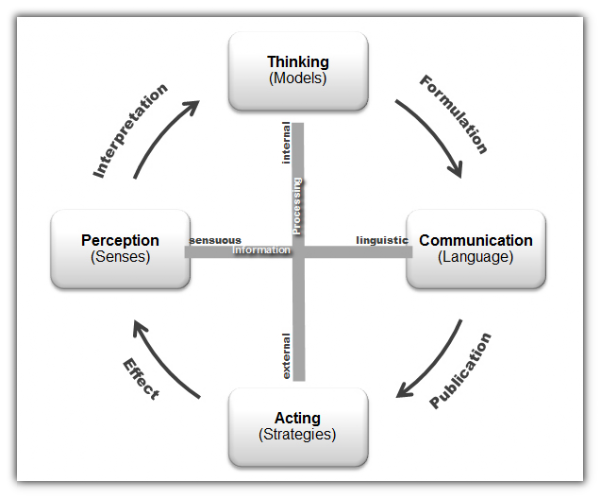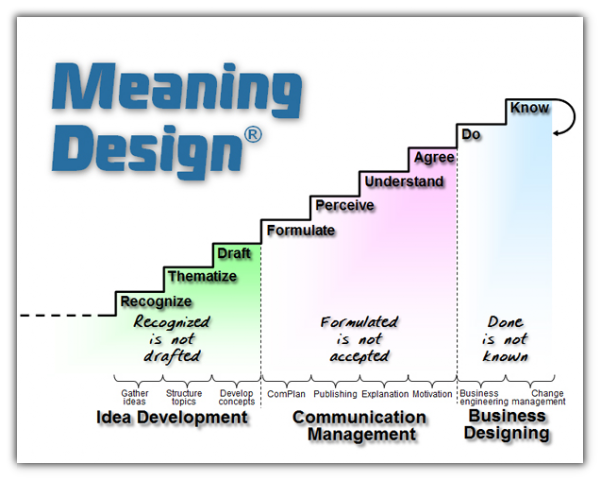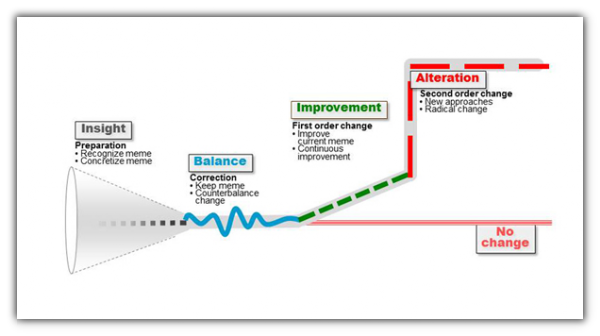Meaning Design
Felt is not recognized;
recognized is not thematized;
thematized is not drafted;
drafted is not formulated;
formulated is not
perceived;
perceived is not understood;
understood is not agreed;
agreed is not
done;
done is not known.
Consciousness
cycle
Meaning design happens continuously – even now. This permanent cycle that allows us to interact with the world could be called consciousness cycle. It consists of four domains: perception, thinking, communication and acting. Our interfaces to the world are our senses (Perception) - 10% of it consciously. We translate those perceived stimuli into thoughts, which are linked with existing mental models and generate new thoughts (Thinking). In order to communicate those, we look for appropriate formulations, thus the correct words. Further means of expression are pictures, music, gestures, body posture, in addition, smell or gourmet creations (Communication). The next step is publication or statement, which is supported by our behavior and action (Act). This leads eventually to perceptible effects, which are perceived by senses. The cycle begins again (see illustration).
The four domains go across two axles: information character and processing level. Information is the interface to the environment and goes from sensuous perception to ‚linguistic’ communication. Processing level describes the form of dealing with the environment and extends from internal thinking to external acting. The result is a holistic, multi-sensual study of the world. Therefore designing of meaning takes care of holistically visual, auditory, kinesthetic, olfactory and gustatory influences, emotional and rational thought processes as well as behaviors and actions.
Perception
Perception
of the world been made with different senses and is the interface of our information
exchange with our Environment. Our eyes have the largest bandwidth of our senses
(40 bits/sec.). They enable us at a dark night to still noticing a candle flame
from 50 km distance. The ears work with 30 bits/sec. and make it possible to hear
ticking a Clock out of over six meters distance. The kinesthetic perception (5
bits/sec.) is sufficient, in order to feel a bee wing that falls from 1cm distance
on our cheek. The nose works with 1 bit/sec. and can perceive a drop perfume that
is distributed in a three-room apartment. The taste nerves (1 bit/sec.) make it
possible to still tasting a teaspoonful sugar dissolved into 7,5 liters of
water. The descriptive realization thresholds are ideal-typical rule of thumb,
which can vary individually. In all fields of life “sense professionals” can be
found, which are able use certain Senses particularly sensitively - e.g. perfumer,
wine connoisseurs, gourmet cooks, ceramists, musicians or photographers.
Out of 100% stimuli that are perceived by our
senses however only 10% become conscious. More would make us crazy. This does
not mean however that this information get lost. Quite the contrary. Perception
stimuli are influence factors of our thinking - consciously and unconsciously.
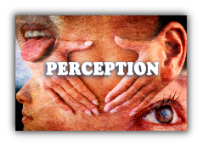
Thinking
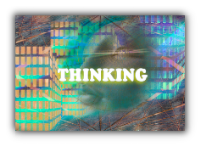
Triggered
by stimuli that are coming from the outside, picked up by our senses, thinking happens
to a large part unconsciously. Results are thoughts, e.g. ideas, topics,
concepts/models, plans or measures. A final explanation how thinking works is
not available yet. However, it is mainly assumed that everyone has its own view
onto the world. This results from personal angle of view, interest and expectations
in this specific moment. Actual thinking is affected by associations, which are
released automatically and are as individual as a fingerprint. This includes
mental models that were developed in the course of life, memories, which result
from past events, as well as abilities, which are continuously acquired and difficult
to express as words. We realize partly results of thinking, and then we process
them. The far larger parts are unconscious results, which affect uncontrolled
and constitute our Intuition, i.e. the gut feeling.
The newest insights
showed that even rational decisions are prepared unconsciously. Thus, thinking
requires new approaches. Means during the meaning design are models, which help
organizing thoughts, e.g. structured explanation, solution and system models.
Results of thinking are the foundation for effective communication.
Communication
Communication covers all elements, which belong
to dissemination of thoughts. Results of thinking lead to more or less
target-group-oriented formulation, which, under use of an appropriate medium, is
transferred. Difficulties of communication are on the one hand the fact that
thereby meaning is lost or at least falsified. On the other hand, receivers define
with their associations and interpretations the meaning that they incorporate
in their consciousness. In the context of communication, meaning design
supports the formal arrangement of messages for the respective communication channels.
However, communication is not terminated with the transmission of the message.
It belongs also the observation of the impact, which reaches the receivers. If
necessary correcting measures are required, this enables receivers to
understand the intended message as well as possible.
In the context
of communication verbalization, the so-called wording plays a central Role. It
should not be ignored that there are further communication channels, apart from
the word. ‚A picture says more than a thousand words’ might be known by
everybody. Apart from visualization, i.e. the figurative conversion of the message,
the processing within other sense domains is becoming increasingly important. Examples
are smells in cars or books, which transport additionally the message of the product.
As consequence of communication, the impact becomes visible in action.
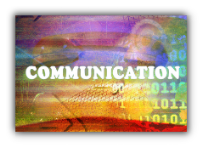
Action
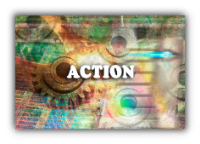
Action consists
of all activities, which usually accompany or follow communication. This
includes behavior, activities and follow-up measures. The visible behavior of
the sender, in the wider surroundings of communication, should fit the message,
e.g. the message „We work in an open organizational culture “requires an appropriate
openness by setting an example. Accompanying activities in the course of publication,
e.g. discussions, explanations and motivation measures, make the message for receivers
understandable. Finally, subsequent activities, which are triggered by the
communication, e.g. measures for the repositioning or future design of organizations,
should fit the original messages. Contrary to thinking, acting is visible to
everybody. Communication is confirmed or questioned by the power of actual doing.
Actions, which do not fit to the original intention, cause expressions like „I
didn’t mean that “or „how can one misunderstand in such a way“.
Meaning design
of action works by the fact that meaning of saying is strengthened or not by
conscious meaning design of doing. This takes place with the positioning and characterization
of groups, the organization of futures as strategy development and even with
the coaching. At the end, it is a matter of designing and controlling the
impact of acting. ‚One cannot not communicate’ means with acting that each activity
ALWAYS implies messages. To consciously steering those, improves the effect for
others. Thus, the circle of consciousness closes and the cycle begins again.
Meaning
design
design
The process of meaning design consists of the
three main phases: idea development, communication management and business designing. In idea development
feelings are consolidated into ideas, then to topics and finally into
alternative concepts. Steps are: gather ideas, structure topics, and develop
concepts. In communication
management, context-related information is prepared, published, discussed and
agreed. Steps are plan communication, publishing, explanation and motivation. Business Designing
converts selected and communicated concepts. Business engineering, information
management, benchmarking, project management and similar management practices are
used. With business designing starts a continuous improvement cycle, in which organization,
processes are adapted to business practice. Steps are businesses engineering
and change management.
Recognize
Ideas come
to your mind surprisingly at any time. These Ideas are perceived in the mind and
often in the whole body. However, even individuals have difficulties to seize
these in words or pictures in order to share it with others. In a group, it is more
challenging than alone, to get into a creative condition, that makes it possible
to jointly formulating ideas. In this first step of idea development, creativity
tools promote the common development of ideas.
A Core element
of meaning design is facilitation of these processes by workshop concepts and
appropriate documentation structures. The basic assumption is to make the various
ideas of the participants by appropriate stimulation visible - Eureka! The idea
is the basis for the next step – Thematize.

Thematize

Topics
result from the review of the ideas, the correspondent problems and the derived
goals. The goals can be derived from the problems by looking at certain aspects
(context, relations, net, associations, pro/con and ecology). Based on the
problem net core problems, causes and effects are described, to transfer them
into a goal net. Goal net consists of the major goal and the supporting
sub-goals as well as the expected effects.
The
compiled sketches are still no concepts. However, that way, ideas are already
substantially more concrete and goals are defined in a first version. The core
elements of the concept can already be identified. These concept alternatives
are compiled in the next step - Draft.
Draft
Concepts
describe alternatives for the realization of a topic. The components that are
relevant for conversion are described in a structured way. The substantial elements
are short description, scope, procedure, SWOT (strengths/ weaknesses and opportunities/
risks), expenditure/benefit as well as a topic evaluation. Emphasis is on a,
objective description of the elements, which are put together in concept alternatives.
From these the favorite is selected. The elaboration of the different perspectives
leads to a more comprehensive view of the solution field. Thus, the viability increases
of eventually selected alternative.
Even if
pragmatic working styles arrive faster into realization, the risk increases by
the lack of a comprehensive concept to have to do time-consuming adjustments in
later phases. This expenditure of additional adjustments exceeds the efforts of
an early concept development by far the original effort. The understanding and
the benefit of this frontloading have made their rounds within technical areas.
In management areas, it is still favored to choose blind actionism over a
structured procedure. Which finally leads to a high degree of failed projects
and continuous request for standards? In the context of meaning design, a
concept that covers most of the aspects is a perfect basis for communication
and business designing.
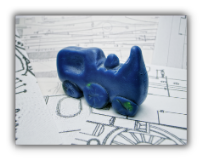
Formulate

The main interest
of formulating is the target-group-oriented formatting of the concept. For this
purpose, the target group is identified, described and profiled as well as informing
and information needs determined. Based on the determined requirements a
communication plan is provided and decided. This offers an overview of all
planned communication measures. These can be publications, meetings or events.
The individual measure follows this schedule during the conversion.
Conscious planning
of communication is often limited to internal communication departments. Meaning
design makes these aspects in business and project business a tool for everybody.
The formulation is the basis for publication and observation of the audience reception
– Perceive.
Perceive
With the publication,
the realization of communication measures takes place. It is accompanied by active
listening and observing. Thus, it is ensured that the planned messages are
understood, desired effects obtained and possibilities for improvement early on
recognized. To achieve this, surveys can be accomplished, mailboxes or on-line
FAQs as well as personal discussions be arranged. Then, the insights are built directly
into the current communication. This can happen several times.
Meaning design
is based on mutual communication. This means that active discussions with target
groups are intended. Difficulties are immediately identified by listening consciously
and making corrections, before they become large problems. The learning curve
rises from measure to measure steeply upward. This is reached by the fact that meanwhile
the audience is understood better and better and communication measures become
more accurately planned. Perceiving is the preparation for the next stage of support
- Understand.
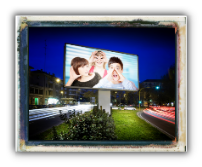
Understand
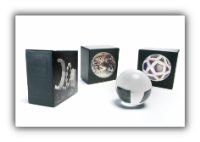
All messages have naturally a large variance of interpretation space. Mental models, memories and abilities as well as expectations and personal views of the events affect the individual view of the event. The consideration of different influence factors makes a better formatting of communication possible. This happens based on generally available information (e.g. facts, opinions and open questions), known associations (e.g. known experiences, mental models and abilities), expectations (concerning doing, results or consequences) and available situation descriptions. Here the communication objects can be examined concerning their message and effectiveness.
Meaning design
goes consciously beyond the actual message and takes care of recognizable
interpretations of the target group. This requires bilateral communication,
which propagates constantly uniform values and messages. The understanding is
the preparation for the last stage of communication management - Agree.
Agree
The
substantial task of communication is to transfer the concepts to the target group,
to promote acceptance, to obtaining consent and to achieve active support. Final
result is positive commitment i.e. readiness to actively support the Concept.
This commitment cannot be forced, but is develop by the audience. The acceptance
creates a motivating framework, which makes agreement easy. Eventually a ritualized
consent promotes anchorage in the mind of the people concerned.
Meaning design
is happening in the head of each individual. This is facilitated by the look at
the mental states of the target group. After commitment is obtained and resistances
are minimized, then, and only then, should start the conversion.

Do

Doing in
the broadest sense is the scope of the business engineering. Business-related aspects
are created practically, implemented and used the first time. Here cause/effect
relations are described in a system model, which links the substantial influence
factors and indicators with one another. In the business model, the actual
business purpose is defined, e.g. deliverable concept, earning model, value-creation
elements. In process maps and detailed process descriptions, business processes
are documented. With business process management, the documented corporate processes
are coordinated and supervised. In parallel, the organization with its role
descriptions (inclusive task, authority, responsibility) is specified and
assigned. The running business uses standardized project management. Doing is traditionally
the area, within which consulting measures can be found.
Meaning design
ensures in this phase that the right thing is done correctly. The meaning for
the corporation, the area or the individual job should be understood this way.
An important condition is the consistent use of the past steps of meaning design.
Thus, management has the chance to make person concerned to participants. The various
documentations are concisely developed according to the quality criteria of meaning
design, target-group-oriented and transparent. Doing is the section of practice,
where concepts are introduced for the first time. Thus the foundation for the
next phase is generated - Ability.
Know
Continuous
learning, enhancement and exercise achieve mastery in an enterprise, area or as
an individual. In order to get an organization, characterized by ability,
appropriate definitions are required. Tools to support are governance, skill management
and a pro-active change management. In governance the organizational core
pillars are described, e.g. principles, guidelines, metrics. In skill management,
roles and skills are integrated into so-called skill sets. The pro-active
change management does not only react to problems, but enables continuous
renewing, as the business (e.g. business model, concepts, and culture) becomes analyzed.
Meaning design
is in this phase particularly challenged, since the results, which were developed
in the past, are being questioned again. In this phase, participation of all stakeholders
is crucial. In principle, this phase never ends, as long as the organization
exists. New ideas can be continuously developed by meaning design and eventually
in this phase built into the current business.

Application
Meaning design
is of special interest, where people fight with meaning. This begins with individuals,
who would like to cope with their understanding of the world - e.g. questions
of personal perception and enhancement, problems and conflicts with others. However,
emphasis lies in social fabrics, groups, organizations and networks. This is
mainly about alignment of different views and interests - e.g. strategy development,
planning of any kind, communication projects, businesses engineering and governance.
Faith in
technology and the rational development of management led to the fact that people
come off badly with their individual interests. Already Michael Hammer noticed
in the context of reengineering that you cannot organize over the heads of people.
Small chances of implementation have the most intelligent solutions, the best projects,
the most effective measures, if participants do not accept them. It is here
where meaning design is applied. Concepts are better prepared, described and communicated.
Communication does not happen one-way, but in dialogue. Management projects are
getting this way a higher implementation probability since the concerned people
become participants.
Target groups
Target groups
are individual, groups, organizations and networks. In the respective application
target groups are defined by geography, economic sectors and the like.
Concentration on target groups enables a better allocation of procedures and tools.
The Individual
is one human with her/his perception, nature, communication as well as his/her thinking
and doing. They are characterized by context, actions, skills and convictions
as well as by identity and affiliation to a larger whole. A group consists of several
people that form a unit based on common goals, values, rules, language or the
like. They have a mutual cohesion and solidarity to each other. An organization
is an abstract thing defined by individuals and groups with a structure and defined
relationships. So in an organization are common group characteristics (e.g.
common rules) as well as structures based on strict division of labor that are planned,
existent for a certain time and held together by a system of formal rules. A network
consists of legally independent units that on one hand are competitors that
cooperate at the same time. On the other hand, a network is characterized by
common goals and structures, which are challenged by polycentric, alternating
power and decision authority.
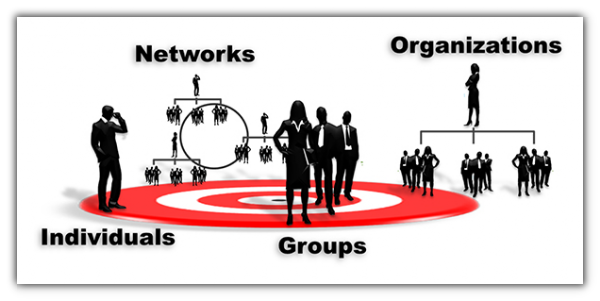
Meaning design
responds especially to the different mixes the mental models and cultures. The various
approaches and tools adapt themselves to the respective target group and stakeholder
profiles.
Benefit
Benefits of
meaning design are the support of the management “Doing the right thing.” Management
methods for the increase of effectiveness and efficiency are available to each
topic in uncountable variants. Meaning design is not in the competition with
these tools, but replenishes them. What is the benefit of consulting results,
if missing focus and lack of understanding develop repeatedly from lacking understanding
and awkward communication. This leads to redundancies, inconsistencies,
unavailable integration and unclear focus as well as general discontent and resistance.
As soon as it is clear, what has to be done, the participants compensate by
their understanding the frequently missing, effective procedure. From it,
suffer quality, transparency as well as the employees, who are not satisfied
with the results.
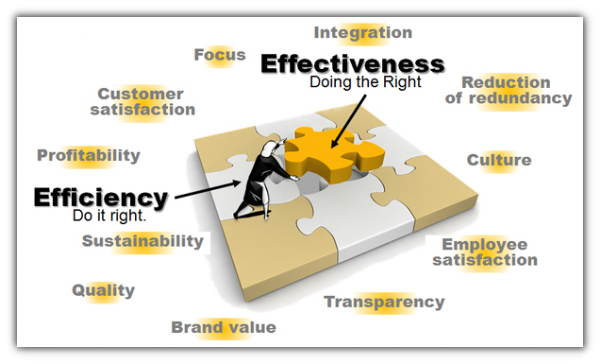
Meaning design
supports with measures that ensure sustainably and economically the focus with
common meaning and a culture that makes it possible for everybody to be successful.
Change dynamics
Change dynamics
define the types of change. This is about gradual differences of change. The
four ideal dynamic ranges go from the determination of the baseline, over
maintaining the current condition, continuous improvement, up to the radical change.
In the
first stage, insight, everybody becomes aware of the actual status and thus the
baseline for further changes created. In the second stage, balance, arising changes
are compensated by purposeful readjustment, in order to maintain the current condition.
Starting from the third stage, change of first order, first small changes are
established. If these improvements happen continuously, this can result on a
long-term basis in large changes. In the last stage of change dynamics, change
of second order, radical changes take place. With this alteration, actions, deliverables
or organizations are omitted. This means that they are no longer done, replaced
by new or even reinvented solutions.
Meaning design
is a change activity and can therefore be classified by the change dynamics.
The core question is: Which degree at change should be supported by meaning design?
Operating conditions
The operating conditions of meaning design depend on the intended change dynamics and the target group.
Individuals look primarily for sense. A group looks for identity, an organization for mission and a network for joint interest.
Depending upon change dynamics (see above)it is about different challenges of meaning.
At the beginning on the level of insight, identity of individuals or Groups is sought. With appropriate self-confidence differences between the own view and the perception of others can be corrected on the level of balance. As soon as the change pressure becomes so strong that the first change steps are considered the level of the improvement is reached. If change pressure continues to increase and fundamental transformation becomes necessary, then on the Level of the alteration radical changes, i.e. fundamental renewal, omission of unwanted parts, replacement of old rules take place.
The symptoms can be found next to the target group (individual, group, organization or network) and are structured according to the change dynamics (cognition, balance, improvement, change).

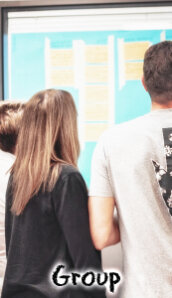

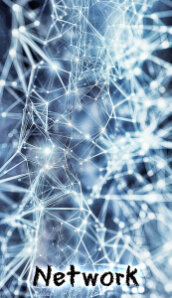
Meaning design
requires the more effort, the more people are involved. However, not only the number
of different perspectives increases complexity. In addition, the cultural characteristics
of different organizations in the enterprises or different companies in a network
increase the efforts.
Deliverables
The deliverables of meaning design extend over the entire spectrum of Consulting: resources, method, analysis and management supply. The supply of resources covers contentual consultation in the form of expertise, workforce and facilitation. Methodical consultation supplies and/or develops together with customer knowledge, procedures and structures, which are locally required. Evaluation-oriented consultation i.e. creative, contentual support offers analyses by neutral Third. Management consultation covers the variants of personality and organizational development, co-ordination, communication, conversion support and change management. Typical results are e.g. problem/goal specification, communication planning, and facilitation.
Employment
of meaning design is recommended as preparing or accompanying measures besides other management measures,
because consultation frequently considers superficially, if at all, the topics
of the meaning design.
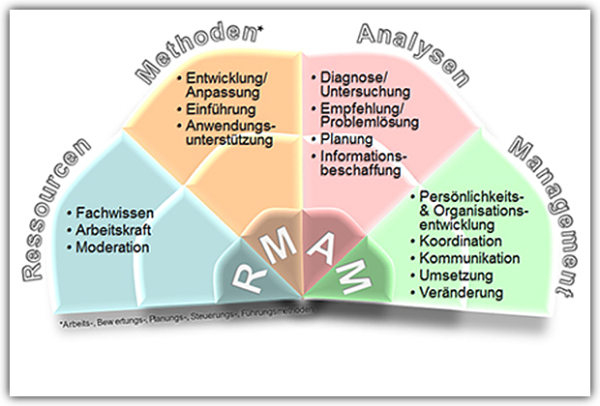

Resources
Content-oriented
consultation offers expertise, work force and facilitation, i.e. the supply of
resources. The selection can take place branch-, function-, process- specific.
Dependent on the topic it concerns technology-, administration- or
service-oriented offers, e.g. facilitation and documentation. Essentially capacity
bottlenecks of the customer are compensated with external capacities or by
consistent outsourcing.
External
resources can temporarily accomplish meaning design. The designing and facilitation
of meaning-oriented workshops about strategy, innovation, organizational development
etc. are possible.

Methoden
Methodical
consultation supplies and/or develops together with the Customers skills, procedures
and structures, which are locally required. It consists of development/ adjustment, rollout and
application support of the methods, e.g. facilitation, strategy development,
communication management. The development of method competences enables
internal performance increase, reduce the loss of core competencies and make ‚aid
in helping yourself’.
Meaning design
is a core topic of any organization. The necessary knowledge can be developed
together with specialists. The framework for such activities offers a strategy
process, governance and business process management.

Analysis
Evaluation-oriented consultation offers creative, contentual support by neutral third. It consists of diagnoses/ researches, recommendations/ problem solving, planning and provision of information. Results are certifications and benchmarking as well as recommendations, solutions, project plans and formatting of researches, e.g. strategy, governance or documentation reviews. In the future, it is possible to offer generally accepted certifications and branch knowledge as well as neutral evaluations and external innovation management by independent Third.
The use of
the methodical approaches of meaning design for the analysis of the own
communication has the potential to achieve a completely different view on the
own corporation. The insights affect over a long period, even without fundamental
introduction of meaning design.

Management
Management
consultation covers the variants of personality and organizational development,
co-ordination, communication, implementation support and change management.
Here it concerns holistic consultation, which combines contentual, methodical
and evaluation-oriented deliverables with coaching. Substantial field of
deployment are changes that have to be mastered by individuals, teams and organizations
concerning their context, doing, abilities, convictions, roles and affiliation.
This can take place in the form of workshops, events, communication measures
and other change-related measures. Operations are regarded holistically as system,
which resembles more a living organism than a wheelwork with computable
dependence. Appropriate advisory activities can be found in the field of change
management, e.g. systemic organization consultation, learning organization,
individual and team coaching.
The leadership
of a business, a product and the employees is in principle classical meaning design.
All stakeholders expect transparency in a format that they can understand and digest.
Technical implementation of the established management methods needs common understanding
of the participants, in order to obtain the desired result. Half of Success is
based on appropriate, goal-oriented communication. Meaning design supplies the
foundation for this.
Glossary
Definition
Iconography
Pattern
Propaganda
Object
Sign
Idea
Certainty
Proselytism
Code
Assumption
Mental model
Characterization
Conviction
Explanation
Description
Meme
Trait theory
Argumentation theory
Domain of discourse
Perspective
Data
Expectation
Generalization
Hermeneutics
Intension
Identity
Public Relations
Information
Entailment
Fiction
Argument
Thesis
Supposition theory
Wisdom
Indoctrination
Intuition
Meaning
Semiotics
Analogy
Opinion
Theory
Polysemy
Homonym
Topic
Pragmatism
Intention
Training
Concept
Transparency
Semantics
Communication
Ambiguity
Suggestion
Conceptual model
Advertising
Visualization
Exegesis
Aesthetics
Presumption
Knowledge
Homophone
Gestalt psychology
Memory
Association
Presupposition
Skill
Are you already curious?
If you are interested for more information, send an e-mail with your contact details.
I will contact you asap. We will then discuss on how to proceed.
Wherever you are in the world - Make the best of it!

